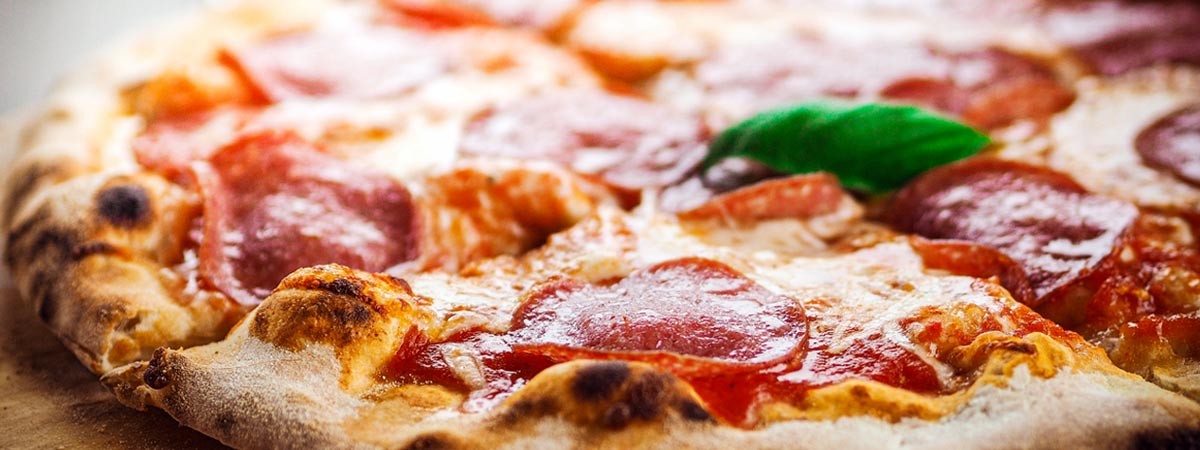How many different methods of food preservation are hidden in one salami pizza? The ingredients for deep-freeze pizzas all come from different factories, each with ways of keeping them fresh en route. One of these methods is thermoforming and tray sealing, supported by vacuum and provided by pumps from Busch.
From mushrooms to cheese, from peppers to salami, the freezers at the supermarket are full of different oven-ready pizzas with a bewildering array of topping combinations. And for each of these combinations, there will most likely be a corresponding combination of preservation methods at work, including modified atmosphere packaging, curing – and, of course, vacuum packaging.
Keeping a favorite fresh
Salami wins hearts time and again as the most popular pizza topping. A doughy base spread with tomato sauce, a generous layer of cheese, and, of course, slices of flavorful salami, and it is ready to be enjoyed. The salami itself scores a winning combination of points for preservation methods: It is a product made of meat that has been dried, fermented, smoked, and cured, meaning that this spicy sausage has already been through four separate forms of preservation before its journey has even begun. Then, to get it ready for pizza, the salami is sliced or diced into cubes. To make sure these pieces do not spoil from one factory to the next, the prepared salami is packaged for transport and storage using vacuum.
Forming and sealing
An effective way of keeping these pieces of salami fresh is by use of thermoforming and tray sealers. Once cut and shaped to requirements, the ready-to-use slices are sent to the packaging station where they are sandwiched between two sheets of film. This packaging station is connected to a vacuum system, which provides vacuum for two different processes. First, the lower layer of film is placed over a mold and heated. Vacuum pulls the plastic into the desired shape, usually a tray-like form. Then, the salami pieces are placed into this newly created receptacle. Once they are in, a second sheet of plastic foil is laid over the top and sealed to the tray below. This time, vacuum extracts all the air between tray and foil. This leaves a covering so tightly packed against the product that it looks just like a second skin. Busch can provide the vacuum system to seal in the flavor and freshness, ensuring safe transport to the final stage of production. When the salami is united with the other ingredients and assembled into the finished pizza, there is just one more step: Quick freezing makes sure the now ready-to-bake pizza can be stored safely for later enjoyment.

Preserving Salami for Pizza
Keeping ingredients fresh from one factory to the next
Pizza far from its roots
What is in a truly traditional pizza? Answers may vary. Pizza as we know it originated in Italy, but similar bread-based dishes have existed in different cultures for centuries. It began as a simple flatbread with cheese, herbs, and a few vegetables, tomatoes entering the picture when they were brought over from the Americas. Since those early days, other countries have adapted, improvised, and innovated, creating a dish to match their population’s own tastes – some of which have overtaken the Italian originals in popularity in their adopted home. For example, American-style deep dish pizza, now known and loved throughout the world, was never part of the original recipe. As the name suggests, it is an entirely American invention, created in Chicago in the early 1900s. And from tuna to shawarma, haggis to spaghetti, different cultures have been topping their dough with more locally inspired cuisine and making it their own for decades.
What is in a truly traditional pizza? Answers may vary. Pizza as we know it originated in Italy, but similar bread-based dishes have existed in different cultures for centuries. It began as a simple flatbread with cheese, herbs, and a few vegetables, tomatoes entering the picture when they were brought over from the Americas. Since those early days, other countries have adapted, improvised, and innovated, creating a dish to match their population’s own tastes – some of which have overtaken the Italian originals in popularity in their adopted home. For example, American-style deep dish pizza, now known and loved throughout the world, was never part of the original recipe. As the name suggests, it is an entirely American invention, created in Chicago in the early 1900s. And from tuna to shawarma, haggis to spaghetti, different cultures have been topping their dough with more locally inspired cuisine and making it their own for decades.